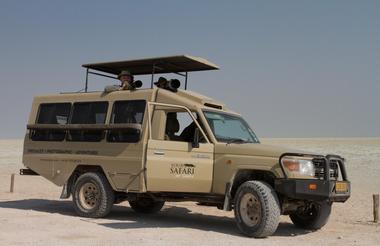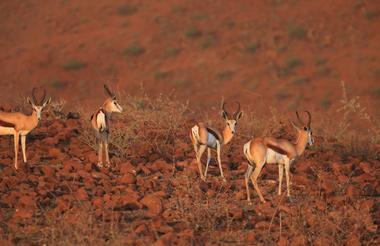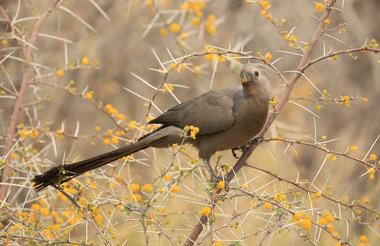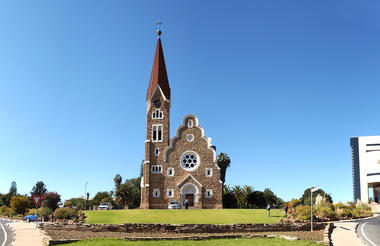You arrive at Windhoek’s Hosea Kutako Airport where will be met by your guide and driven the short distance to your overnight accommodation at the Trans Kalahari Inn where you can meet the other members of the group over dinner and relax on your first night. The Inn has lovely thatched rooms, friendly staff, a swimming pool and bar and one of the best restaurants in Windhoek - a perfect first night stop over before your adventure begins the following day.



Trans Kalahari Inn - The relatively close proximity to Windhoek airport makes the Trans Kalahari Inn a great first and last overnight stop.
The terrace is a perfect place to meet your fellow travellers and enjoy your first sundowner together and the on-site restaurant serves lovely food all day.
After an early breakfast we set off north on the main tar road out of Windhoek stopping en- route for lunch. By mid-afternoon we will arrive at the Andersson Gate in Central Etosha where we begin the start of your safari in this world-famous wildlife sanctuary. This huge park is home to an amazing diversity of wildlife and the Okaukuejo area is known for its open plains and wide vistas where vast herds of herbivores trek endlessly to the camp’s floodlit waterhole followed by the ever present carnivores looking for their next meal.



Okaukuejo Area Highlights: the camp’s own floodlit waterhole is a real highlight which has nightly visits by black rhino and elephant. The whole area is dominated by vast open plains where large herds of herbivores graze. The Okondeka waterhole on the pan’s edge is often frequented by one of the largest lion prides in the area and to the east of the camp are three further productive waterholes known for elephants, lion, leopard, spotted and brown hyena, zebra, gemsbok, springbok, wildebeest, ostrich and occasionally aardwolf. The open plains are also good for the larger birds of prey such as vultures, several eagle species and peregrine falcons.
We have the whole day to explore the open plains that surround Okaukuejo Camp and the Mopane woodlands east of the camp around Olifantsbad waterhole.
We will check the sightings book twice a day to check on any major recorded sightings and spend our morning and afternoon drives in search of Etosha's wildlife.
At the camp's own waterhole large herds of elephants often come down to drink and dust bathe before heading back into the bush and black rhinos often frequent the whole from 9pm onwards and throughout the night



The Okondeka waterhole on the pan’s edge is often frequented by one of the largest lion prides in the area and to the east of the camp are three further productive waterholes known for elephants, lion, leopard, spotted and brown hyena, zebra, gemsbok, springbok, wildebeest, ostrich and occasionally aardwolf. The open plains are also good for the larger birds of prey such as vultures, several eagle species and peregrine falcons.
This morning we travel into the wooded area surrounding Halali Camp. Along the way we revisit the nearby Nebrowni and Olifantsbad waterholes before leaving the central plains behind and heading into the wooded area around Homob. This double waterhole has a huge reed bed and is in a natural bowl. It is very scenic and often produces interesting sightings.



Halali Area Highlights: the camp’s own floodlit waterholes is another real highlight. The viewing area looks down on the pool giving a real sense of theatre as animals come to drink. Halali sits amongst Mopani woodland and there are several waterholes near camp that are surrounded by trees and are frequented by woodland species such as red hartebeests, black faced impala, kudu, eland as well as elephant, lion, leopard, zebra, oryx and giraffe. On the pan’s edge there are several key waterholes that are home to large herds of zebra and springbok who are preyed on by several lion prides and cheetah.
A full day today to explore this diverse sector which has both Mopani woodland and dry savannah that rolls down to the very edge of the giant salt pan. The floodlit waterhole is a real highlight of this camp with black rhino and huge herds of elephants often seen along with porcupines, honey badgers and even the ever elusive leopard.



To the west of camp there is a trilogy of waterholes called, Salvadora, Charitsaub and Sueda and it is usual to see the resident pride in one of the three. To the east lies the central wooded area with key waterholes such as Goas and Nuamses. This area is often excellent for sightings of large elephant herds and is possibly one of the best places in Etosha to see leopard
We head east once more today towards Namutoni Camp and the wildlife rich acacia woodland around Fischer’s Pan. Not only is this area home to some of Etosha’s largest lion prides,cheetah sightings here are frequent, this area is home to the majority of the park’s giraffe and it is one of the best places in Africa to see the world’s smallest antelope, the diminutive Damara Dik-Dik.



Namutoni Area Highlights: within a few kilometres from camp there are several excellent waterholes and two in particular are productive all day. There is a very large hyena clan near one of the waterholes and the members are often seen returning to their den early in the morning. All the main carnivores are often spotted in this area and cheetah are often seen hunting around Fischer’s Pan. Good area for lion, hyena, leopard, cheetah, elephants, black rhino, damara dik-dik, all plains game, warthogs and mongooses. Flamingos and pelicans can be seen in Fischer’s Pan after the rains.
There are many key waterholes within a few kilometres of Namutoni Camp so we can spend our game drives looping back to camp for quick comfort breaks before we head off again to other areas.
The camp has a lovely pool area that sells lunchtime toasties and beers and the evening restaurant has an outside seating area and good food.



Evening drives are best spent at two productive waterholes,: Chudop is good both early morning and all day for herbivores, especially giraffe. For the last hour Klein Namutoni waterhole is often very rewarding and has perfect photographic light and offers the added bonus of a perfect African sunset on the way back to camp
A slow morning drive to Twee Palms waterhole to the east of camp often rewards with good cheetah sightings as they hunt along the edges of Fischer's Pan.
For our sundowner drive we concentrate on Chudop and Klein Namutoni just a few kilometres from camp which optimises our time out in the park



Early mornings and leaving the camp at first light is essential for wildlife photography and it is often the best time of day to see lion and leopard before the heat of the day forces them into the shade.
Cheetah are diurnal hunters and can be seen throughout the day although many of the best sightings are later in the afternoon when the plains cool down a little.
After a final game drive we leave the peace and quiet of Etosha and head south on the tar road until we reach the gates to Okonjima. The lodge lies a further 24km into the middle of the mountains and it is here we will spend our last night searching for some of the Africa’s biggest carnivores. On our game drives out in the 54,000 reserve we will have the opportunity to track leopard and brown hyena with the aid of a telemetry and visit the Africat Foundation. With its magnificent rooms, excellent cuisine and genuine conservation story, Okonjima is always a highlight of any trip to Namibia



Okonjima is not only a luxury lodge and a wonderful place to spend your last night in Namibia it is also home to the AfriCat Foundation.
Africat is a non-profit organisation set up to support conservation through education and to help secure the future of Namibia's endangered carnivores.
With opportunities to track leopard in the 54,000 acre reserve and the new Endangered Wildlife Trail. Okonjima gives you chances to see some of Africa's rarely seen animals such as brown hyena, aardwolf, aardvark and pangolin
Whilst staying at the lodge you will be able to actively observe part of this programme and understand how Africat aims to protect and rehabilitate these endangered carnivores.
At the Carnivore Care Centre you will have the opportunity to photograph cheetah in their natural habitat within their large enclosures while your guide explains in detail how the programme works.
We leave Okonjima this morning after our morning trail and retrace out steps back down the tar road south until we arrive once more at the Trans Kalahari Inn where we can discuss the highlights of our tour over a final sun downer on the terrace.








